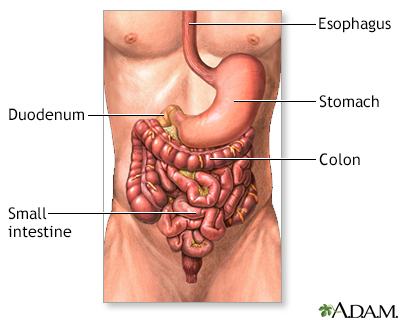Stools – floating
Definition
Stools that float are most often due to poor absorption of nutrients (malabsorption) or too much gas (flatulence).
Alternative Names
Floating stools
Considerations
Most causes of floating stools are harmless. In most cases, floating stools will go away without treatment.
Floating stools alone are not a sign of an illness or other health problem.
Causes
Many things can cause floating stools. Most of the time, floating stools are due to what you eat. A change in your diet may cause an increase in gas. Increased gas in the stool allows it to float.
Floating stools may also happen if you have a gastrointestinal infection.
Floating, greasy stools that are foul smelling may be due to severe malabsorption, particularly if you are losing weight. Malabsorption means your body is not properly absorbing nutrients.
Most floating stools are not caused by an increase in the fat content of the stool. However, in some conditions, such as long-term (chronic) pancreatitis, the fat content is increased.
Home Care
If a change in diet has caused floating stools or other health problems, try to find which food is to blame. Avoiding this food may be helpful.
When to Contact a Medical Professional
Tell your health care provider if you have changes in your stools or bowel movements. Contact your provider right away if you have bloody stools with weight loss, dizziness, and fever.
What to Expect at Your Office Visit
Your provider will perform a physical exam and ask questions about your medical history and symptoms, such as:
- When did you first notice the floating stools?
- Does it happen all the time or from time to time?
- What is your usual diet?
- Does a change in your diet change your stools?
- Do you have other symptoms?
- Are the stools foul smelling?
- Are the stools an abnormal color (such as pale or clay-colored stools)?
A stool sample may be needed. Blood tests may be done. In most cases, however, these tests will not be needed.
Treatment depends on the specific diagnosis.
Gallery

References
Höegenauer C, Hammer HF. Maldigestion and malabsorption. In: Feldman M, Friedman LS, Brandt LJ, eds. Sleisenger and Fordtran's Gastrointestinal and Liver Disease. 11th ed. Philadelphia, PA: Elsevier; 2021:chap 104.
Schiller LR, Sellin JH. Diarrhea. In: Feldman M, Friedman LS, Brandt LJ, eds. Sleisenger and Fordtran's Gastrointestinal and Liver Disease. 11th ed. Philadelphia, PA: Elsevier; 2021:chap 16.
Semrad CE. Approach to the patient with diarrhea and malabsorption. In: Goldman L, Schafer AI, eds. Goldman-Cecil Medicine. 26th ed. Philadelphia, PA: Elsevier; 2020:chap 131.